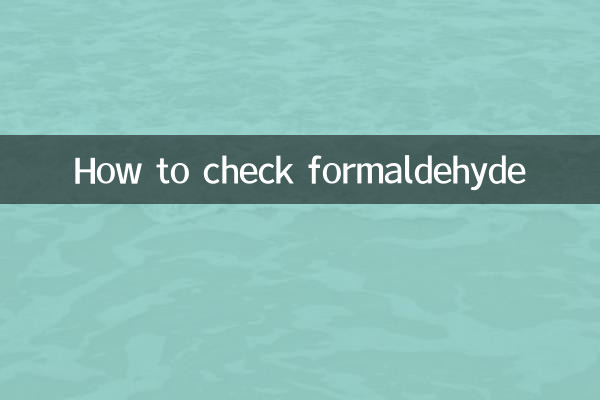How to Check Formaldehyde: A Comprehensive Guide Combined with the Latest Hot Topics
Formaldehyde is a common indoor air pollutant and long-term exposure can cause serious health effects. As people pay more attention to indoor air quality, how to check formaldehyde has become a hot topic. This article will provide you with a structured formaldehyde testing guide based on hot content from the entire Internet in the past 10 days.
1. The relationship between recent hot topics and formaldehyde detection

According to the data analysis of the entire network, the hot topics related to formaldehyde in the past 10 days are mainly concentrated in the following aspects:
| Ranking | hot topics | Relevance | Search volume trends |
|---|---|---|---|
| 1 | Formaldehyde removal after decoration of new house | high | up 32% |
| 2 | Formaldehyde Detector Buying Guide | extremely high | up 45% |
| 3 | Formaldehyde poisoning symptoms | in | up 18% |
| 4 | Formaldehyde content of environmentally friendly building materials | high | up 25% |
| 5 | Professional formaldehyde testing agency | extremely high | up 38% |
2. Complete list of formaldehyde detection methods
According to current market demand and technological development, the following is a comparison of mainstream formaldehyde detection methods:
| Detection method | Advantages | Disadvantages | Suitable for the scene | Accuracy | cost |
|---|---|---|---|---|---|
| Professional testing agency | Authoritative results and accurate data | The cost is high and you have to wait for an appointment | New house acceptance and legal disputes | ★★★★★ | 500-1500 yuan |
| Electronic detector | Instant readings, reusable | Requires calibration and is affected by the environment | daily monitoring | ★★★☆☆ | 200-2000 yuan |
| Kit detection | Simple operation and low cost | Results are rough and susceptible to interference | initial screening | ★★☆☆☆ | 20-100 yuan |
| Plant detection method | No cost, natural and environmentally friendly | For reference only, no specific data | Auxiliary observation | ★☆☆☆☆ | 0 yuan |
3. Detailed step-by-step explanation of the formaldehyde detection process
Step 1: Determine the purpose of testing
Is it used for daily monitoring or legal evidence collection? Different purposes determine the choice of detection methods.
Step 2: Choose the appropriate method
Based on budget, timeliness requirements and accuracy requirements, select the most suitable detection method from the table above.
Step 3: Prepare for testing
Close doors and windows for more than 12 hours, keep the indoor temperature at around 25°C, and remove sources of interference such as perfumes and detergents.
Step 4: Standardize sampling
For professional testing, the sampling height should be between 0.8-1.5 meters, avoiding vents and sources of pollution.
Step 5: Interpretation of results
According to the "Indoor Air Quality Standards" (GB/T18883-2022), the formaldehyde limit is 0.08mg/m³.
4. Latest detection technology trends
Recently popular new detection technologies include:
1.Intelligent connected detection system: Can be monitored in real time through APP, and data is stored in the cloud.
2.Nanosensor Technology: Higher sensitivity and faster response
3.Multi-parameter detector: Can detect formaldehyde, TVOC, PM2.5 and other indicators at the same time
5. Frequently Asked Questions
Q: What is the difference between a detector worth a few hundred yuan and a detector worth several thousand yuan?
A: The main differences are sensor accuracy, calibration cycle, anti-interference ability and service life.
Q: Are self-test results legally valid?
A: No. Legally recognized testing must be completed by an institution with CMA qualifications.
Q: What time points should be paid attention to during detection?
A: The best inspection time is more than 7 days after the decoration is completed and more than 3 days after the furniture comes into the site.
6. Safety suggestions
1. If the test finds that the standard exceeds the standard, ventilation measures should be taken immediately
2. Pregnant women, children, and the elderly should avoid staying in the newly renovated environment for a long time.
3. The formaldehyde release cycle lasts for 3-15 years and requires continuous attention.
Through the above structured guide, I believe you have a comprehensive understanding of how to scientifically detect formaldehyde. In light of current hot issues, we suggest that consumers should consider both cost-effectiveness and data accuracy when choosing testing methods, so as to ensure the health of their families as the first priority.

check the details

check the details